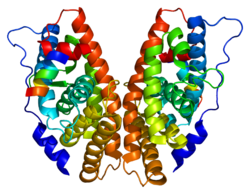Do you ever wonder how some people just seem to run
marathons with ease or can inherently memorize things such as times tables and trivia
facts? As it turns out, these two skills are linked in
ways scientists didn’t know were possible. In fact, a recent study by Salk
scientists in Cell Metabolism argues
that physical and mental activities rely on a single metabolic protein that
controls the flow of blood and nutrients throughout the body, which could lead
future researchers to potential treatments in regenerative and developmental
medicine while simultaneously educating the general population about the
defects in human learning and memory. Ronald Evans, the senior author of the
study and director of the Salk Gene Expression lab, claims this protein
enables the heart and muscles to gain a surge of energy to improve physical
performance and endurance, as well as energizing the neurons responsible for
information recall and long-term memory.
 |
| Estrogen-related receptor gamma |
The
protein, called estrogen-related receptor gamma (ERRγ), has been previously
studied in 2011 in cardiology and its impact on skeletal muscles. In fact, promoting
ERRγ activity in the skeletal muscle of mice “increased blood supply to their
muscles and doubled their running capacity”, effectively turning on a whole
host of muscle genes that can convert fat to energy. Could this protein be the
master metabolic switch to long-lasting energy?
Despite
these promising findings, many scientists had a hard time explaining their
findings in the brain, as the brain burns sugar and ERRγ was previously shown
to only burn fat. However, corresponding author Liming Pei, observed isolated
neurons and found that ERRγ activates dozens of metabolic genes in brain cells
and that neurons that lacked this protein could not produce as much ATP and did
not perform as well. These researchers have now concluded that ERRγ turns on
fat-burning pathways in muscles and sugar-burning pathways in the brain, with
the most active ERRγ brain region being the hippocampus, an energetically
demanding region directly involved in learning and memory.
They
found that mice without ERRγ had normal vision, movement and balance, but had
slower learning curves when swimming through a water maze and had troubles
remembering the course in future trials compared to mice with the ERRγ protein
being expressed.
The
bottom line with this exciting research is that varying levels of ERRγ expression
could potentially explain the differences in how each human learn and could be
linked to changes in brain metabolism.
However,
future research would provide a better understanding of the metabolism of
neurons and pave the way to improved treatment and support for learning and
attention deficit disorders. Since memory has an inherent metabolic scaffold,
understanding the circuits behind the process of memory could lead researchers
to an overall better understanding of learning. And, who knows? Perhaps high
ERRγ levels could enhance learning in the end, just as it enhances muscle
function.
Posted by: Rebecca Quirie (C)

Once this research progresses more, do you think lesson plans could be developed to help kids with more/less of this protein? If it helps explain why people learn differently maybe knowing this information could really help some adolescents who have trouble remembering things.
ReplyDelete-Carolyn McDonagh
Hi Carolyn,
ReplyDeleteI totally think the expression of this protein in different students could contribute to more personalized and effective lesson plans. Every student is unique and students who are gifted in memory tend to be favored by the education system, which is unfair to others. Maybe grouping these super-learners into a gifted-like program would make it easier to accommodate all learning styles.
-Rebecca Quirie